Experiments on Pilot-Scale Constructed Floating Wetlands Efficiency in Removing Agrochemicals
Abstract
:1. Introduction
2. Materials and Methods
2.1. Experimental Parameters
2.2. Sample Preparation
2.3. Chemicals, Analyses and Instrumentation
2.4. Estimation of Pollutant Reductions
2.5. Statistical Analysis
3. Results and Discussion
3.1. Physicochemical Parameters
3.2. Nutrients
3.3. Pesticides
3.4. Meteorological Conditions
3.5. Statistical Analysis Results
4. Conclusions
Author Contributions
Funding
Institutional Review Board Statement
Informed Consent Statement
Data Availability Statement
Conflicts of Interest
References
- Zotou, I.; Tsihrintzis, V.A.; Gikas, G.D. Performance of seven water quality indices (WQIs) in a Mediterranean River. Environ. Monit. Assess. 2019, 191, 505. [Google Scholar] [CrossRef] [PubMed]
- Pavlidis, G.; Zotou, I.; Karasali, H.; Marousopoulou, A.; Bariamis, G.; Tsihrintzis, V.A.; Nalbantis, I. Performance of pilot-scale constructed floating wetlands in the removal of nutrients and pesticides. Water Resour. Manag. 2022, 36, 399–416. [Google Scholar] [CrossRef]
- Pavlidis, G.; Tsihrintzis, V.A. Environmental benefits and control of pollution to surface water and groundwater by agroforestry systems: A review. Water Resour. Manag. 2018, 32, 1–29. [Google Scholar] [CrossRef]
- Ladislas, S.A.; El-Mufleh, A.C.; Gerente, C.F.; Chazarenc, F.Y.; Andres, Y.B.; Bechet, B. Potential of aquatic macrophytes as bioindicators of heavy metal pollution in urban stormwater runoff. Water Air Soil Pollut. 2012, 223, 877–888. [Google Scholar] [CrossRef]
- Stefanakis, A.; Akratos, C.S.; Tsihrintzis, V.A. Vertical Flow Constructed Wetlands: Eco-Engineering Systems for Wastewater and Sludge Treatment; Elsevier: Amsterdam, The Netherlands, 2014; 378p. [Google Scholar]
- Alemu, T.; Lemma, E.; Mekonnen, A.; Leta, S. Performance of pilot scale anaerobic-SBR system integrated with constructed wetlands for the treatment of tannery wastewater. Environ. Process. 2016, 3, 815–827. [Google Scholar] [CrossRef]
- Pavlineri, N.; Skoulikidis, N.T.; Tsihrintzis, V.A. Constructed floating wetlands: A review of research, design, operation and management aspects, and data meta-analysis. Chem. Eng. J. 2017, 308, 1120–1132. [Google Scholar] [CrossRef]
- Mustafa, H.M.; Hayder, G. Recent studies on applications of aquatic weed plants in phytoremediation of wastewater: A review article. Ain Shams Eng. J. 2020, 12, 355–365. [Google Scholar] [CrossRef]
- Sharma, S.; Singh, B.; Manchanda, V.K. Phytoremediation: Role of terrestrial plants and aquatic macrophytes in the remediation of radionuclides and heavy metal contaminated soil and water. Environ. Sci. Pollut. Res. 2015, 22, 946–962. [Google Scholar] [CrossRef]
- Angassa, K.; Leta, S.; Mulat, W.; Kloos, H.; Meers, E. Evaluation of pilot-scale constructed wetlands with Phragmites karka for phytoremediation of municipal wastewater and biomass production in Ethiopia. Environ. Process. 2019, 6, 65–84. [Google Scholar] [CrossRef]
- Pavlidis, G.; Karasali, H. Natural Remediation Techniques for Water Quality Protection and Restoration. In Methods for Bioremediation of Water and Wastewater Pollution; Springer: Cham, Switzerland, 2020; pp. 327–340. [Google Scholar]
- Kadlec, R.H.; Wallace, S. Treatment Wetlands; CRC Press: Boca Raton, FL, USA, 2008. [Google Scholar]
- Akratos, C.S.; Tsihrintzis, V.A. Effect of temperature, HRT, vegetation and porous media on removal efficiency of pilot-scale horizontal subsurface flow constructed wetlands. Ecol. Eng. 2007, 29, 173–191. [Google Scholar] [CrossRef]
- Papadopoulos, F.H.; Tsihrintzis, V.A. Assessment of a Full-Scale Duckweed Pond System for Septage Treatment. Environ. Technol. 2011, 32, 795–804. [Google Scholar] [CrossRef] [PubMed]
- Kotti, I.P.; Sylaios, G.K.; Tsihrintzis, V.A. Fuzzy modeling for nitrogen and phosphorus removal estimation in free-water surface constructed wetlands. Environ. Process. 2016, 3, 65–79. [Google Scholar] [CrossRef]
- Rezania, S.; Taib, S.M.; Din, M.F.M.; Dahalan, F.A.; Kamyab, H. Comprehensive review on phytotechnology: Heavy metals removal by diverse aquatic plants species from wastewater. J. Hazard. Mater. 2016, 318, 587–599. [Google Scholar] [CrossRef] [PubMed]
- Tsihrintzis, V.A. The Use of Vertical Flow Constructed Wetlands in Wastewater Treatment. Water Resour. Manag. 2017, 31, 3245–3270. [Google Scholar] [CrossRef]
- Zhou, X.; He, Z.L.; Jones, K.D.; Li, L.; Stoffella, P.J. Dominating aquatic macrophytes for the removal of nutrients from waterways of the Indian River Lagoon basin, South Florida, USA. Ecol. Eng. 2017, 101, 107–119. [Google Scholar] [CrossRef]
- Papadopoulos, N.; Zalidis, G. The use of Typha Latifolia, L. in constructed wetland microcosms for the remediation of herbicide terbuthylazine. Environ. Process. 2019, 6, 985–1003. [Google Scholar] [CrossRef]
- Wang, J.; Wang, W.; Xiong, J.; Li, L.; Zhao, B.; Sohail, I.; He, Z. A constructed wetland system with aquatic macrophytes for cleaning contaminated runoff/storm water from urban area in Florida. J. Environ. Manag. 2021, 280, 111794. [Google Scholar] [CrossRef]
- Kotti, E.P.; Gikas, G.D.; Tsihrintzis, V.A. Effect of Temperature, HRT, Vegetation and Porous Media on Removal Efficiency of Pilot-Scale Free Water Surface Flow Constructed Wetlands. Ecol. Eng. 2010, 36, 862–875. [Google Scholar] [CrossRef]
- Papadopoulos, F.H.; Tsihrintzis, V.A.; Zdragas, A.G. Removal of Faecal Bacteria from Septage by Treating it in a Full-scale Duckweed-covered Pond System. J. Environ. Manag. 2011, 92, 3130–3135. [Google Scholar] [CrossRef]
- Stefanakis, A.I.; Tsihrintzis, V.A. Effect of Loading, Resting Period, Temperature, Porous Media, Vegetation and Aeration on Performance of Pilot-scale Vertical Flow Constructed Wetlands. J. Chem. Eng. 2012, 181–182, 416–430. [Google Scholar] [CrossRef]
- Stefanakis, A.I.; Tsihrintzis, V.A. Heavy Metal Fate in Pilot-scale Sludge Drying Reed Beds under Various Design and Operation Conditions. J. Hazard. Mater. 2012, 213–214, 393–405. [Google Scholar] [CrossRef] [PubMed]
- Papaevangelou, V.A.; Gikas, G.D.; Tsihrintzis, V.A.; Antonopoulou, M.; Konstantinou, I.K. Removal of Endocrine Disrupting Chemicals in HSF and VF Pilot-scale Constructed Wetlands. Chem. Eng. J. 2016, 294, 146–156. [Google Scholar] [CrossRef]
- Gikas, G.D.; Pérez-Villanueva, M.; Tsioras, M.; Alexoudis, C.; Pérez-Rojas, G.; Masís-Mora, M.; Lizano-Fallas, V.; Rodríguez-Rodríguez, C.E.; Vryzas, Z.; Tsihrintzis, V.A. Low-cost Approaches for the Removal of Terbuthylazine from Agricultural Wastewater: Constructed Wetlands and Biopurification System. Chem. Eng. J. 2017, 335, 647–656. [Google Scholar] [CrossRef]
- Papaevangelou, V.A.; Gikas, G.D.; Tsihrintzis, V.A. Chromium Removal from Wastewater Using HSF and VF Pilot-Scale Constructed Wetlands: Overall Performance, and Fate and Distribution of this Element within the Wetland Environment. Chemosphere 2017, 168, 716–730. [Google Scholar] [CrossRef]
- Papaevangelou, V.A.; Gikas, G.D.; Vryzas, Z.; Tsihrintzis, V.A. Treatment of agricultural equipment rinsing water containing a fungicide in pilot-scale horizontal subsurface flow constructed wetland. Ecol. Eng. 2017, 101, 193–200. [Google Scholar] [CrossRef]
- Gikas, G.D.; Vryzas, Z.; Tsihrintzis, V.A. S-metolachlor Herbicide Removal in Pilot-scale Horizontal Subsurface Flow Constructed Wetlands. Chem. Eng. J. 2018, 339, 108–116. [Google Scholar] [CrossRef]
- Gikas, G.D.; Papaevangelou, V.A.; Tsihrintzis, V.A.; Antonopoulou, M.; Konstantinou, I.K. Removal of emerging pollutants in HSF and VF pilot-scale constructed wetlands. Processes 2021, 9, 2200. [Google Scholar] [CrossRef]
- Gikas, G.D.; Vryzas, Z.; Karametos, I.; Tsihrintzis, V.A. Pyraclostrobin removal in pilot-scale horizontal subsurface flow constructed wetlands and in porous media filters. Processes 2022, 10, 414. [Google Scholar] [CrossRef]
- Díaz, F.J.; Anthony, T.O.; Dahlgren, R.A. Agricultural pollutant removal by constructed wetlands: Implications for water management and design. Agric. Water Manag. 2012, 104, 171–183. [Google Scholar] [CrossRef]
- Ioannidou, V.G.; Pearson, J.M. Hydraulic and design parameters in full-scale constructed wetlands and treatment units: Six case studies. Environ. Process. 2018, 5, 5–22. [Google Scholar] [CrossRef]
- Srivastava, J.; Gupta, A.; Chandra, H. Managing water quality with aquatic macrophytes. Rev. Environ. Sci. Biotechnol. 2008, 7, 255–266. [Google Scholar] [CrossRef]
- Priya, A.; Avishek, K.; Pathak, G. Assessing the potentials of Lemna minor in the treatment of domestic wastewater at pilot scale. Environ. Monit. Assess. 2012, 184, 4301–4307. [Google Scholar] [CrossRef] [PubMed]
- Abdul Aziz, N.I.H.; Mohd Hanafiah, M.; Halim, N.H.; Fidri, P.A.S. Phytoremediation of TSS, NH3-N and COD from Sewage Wastewater by Lemna minor L.; Salvinia minima, Ipomea aquatica and Centella asiatica. Appl. Sci. 2020, 10, 5397. [Google Scholar] [CrossRef]
- Sarkheil, M.; Safari, O. Phytoremediation of nutrients from water by aquatic floating duckweed (Lemna minor) in rearing of African cichlid (Labidochromis lividus) fingerlings. Environ. Technol. Innov. 2020, 18, 100747. [Google Scholar] [CrossRef]
- Liu, C.; Dai, Z.; Sun, H. Potential of duckweed (Lemna minor) for removal of nitrogen and phosphorus from water under salt stress. J. Environ. Manag. 2017, 187, 497–503. [Google Scholar] [CrossRef] [Green Version]
- Ceschin, S.; Sgambato, V.; Ellwood, N.T.W.; Zuccarello, V. Phytoremediation performance of Lemna communities in a constructed wetland system for wastewater treatment. Environ. Exp. Bot. 2019, 162, 67–71. [Google Scholar] [CrossRef]
- Kamyab, H.; Chelliapan, S.; Din, M.F.M.; Shahbazian-Yassar, R.; Rezania, S.; Khademi, T.; Kumar, A.; Azimi, M. Evaluation of Lemna minor and Chlamydomonas to treat palm oil mill effluent and fertilizer production. J. Water Process. Eng. 2017, 17, 229–236. [Google Scholar] [CrossRef]
- Sudiarto, S.I.A.; Renggaman, A.; Choi, H.L. Floating aquatic plants for total nitrogen and phosphorus removal from treated swine wastewater and their biomass characteristics. J. Environ. Manag. 2019, 231, 763–769. [Google Scholar] [CrossRef]
- Dosnon-Olette, R.; Couderchet, M.; Eullaffroy, P. Phytoremediation of fungicides by aquatic macrophytes: Toxicity and removal rate. Ecotoxicol. Environ. Saf. 2009, 72, 2096–2101. [Google Scholar] [CrossRef]
- Dosnon-Olette, R.; Couderchet, M.; Biagianti, S.; Eullaffroy, P. Toxicity and removal of pesticides by selected aquatic plants. Chemosphere 2008, 70, 1414–1421. [Google Scholar] [CrossRef]
- Dosnon-Olette, R.; Couderchet, M.; El Arfaoui, A.; Sayen, S.; Eullaffroy, P. Influence of initial pesticide concentrations and plant population density on dimethomorph toxicity and removal by two duckweed species. Sci. Total Environ. 2010, 408, 2254–2259. [Google Scholar] [CrossRef] [PubMed]
- Prasertsup, P.; Ariyakanon, N. Removal of chlorpyrifos by water lettuce (Pistia stratiotes L.) and duckweed (Lemna minor L.). Int. J. Phytoremediation 2011, 13, 383–395. [Google Scholar] [CrossRef] [PubMed]
- Dosnon-Olette, R.; Couderchet, M.; Oturan, M.A.; Oturan, N.; Eullaffroy, P. Potential use of Lemna minor for the phytoremediation of isoproturon and glyphosate. Int. J. Phytoremediation 2011, 13, 601–612. [Google Scholar] [CrossRef] [PubMed]
- Rice, P.J.; Anderson, T.A.; Coats, J.R. Phytoremediation of herbicide-contaminated surface water with aquatic plants. ACS Publ. 1997, 10, 133–151. [Google Scholar] [CrossRef] [Green Version]
- Mitsou, K.; Koulianou, A.; Lambropoulou, D.; Pappas, P.; Albanis, T.; Lekka, M. Growth rate effects, responses of antioxidant enzymes and metabolic fate of the herbicide Propanil in the aquatic plant Lemna minor. Chemosphere 2006, 62, 275–284. [Google Scholar] [CrossRef] [PubMed]
- Gatidou, G.; Stasinakis, A.S.; Iatrou, E.I. Assessing single and joint toxicity of three phenylurea herbicides using Lemna minor and Vibrio fischeri bioassays. Chemosphere 2015, 119, S69–S74. [Google Scholar] [CrossRef] [PubMed]
- Wang, F.; Liu, D.; Qu, H.; Chen, L.; Zhou, Z.; Wang, P. A full evaluation for the enantiomeric impacts of lactofen and its metabolites on aquatic macrophyte Lemna minor. Water Res. 2016, 101, 55–63. [Google Scholar] [CrossRef]
- Tagun, R.; Boxall, A.B. The Response of Lemna minor to Mixtures of Pesticides that are Commonly used in Thailand. Bull. Environ. Contam Toxicol. 2018, 100, 516–523. [Google Scholar] [CrossRef] [Green Version]
- Kostopoulou, S.; Ntatsi, G.; Arapis, G.; Aliferis, K.A. Assessment of the effects of metribuzin, glyphosate, and their mixtures on the metabolism of the model plant Lemna minor L. applying metabolomics. Chemosphere 2020, 239, 124582. [Google Scholar] [CrossRef]
- Fox, L.J.; Struik, P.C.; Appleton, B.L.; Rule, J.H. Nitrogen phytoremediation by water hyacinth (Eichhornia crassipes (Mart.) Solms). Water Air Soil Pollut. 2008, 194, 199–207. [Google Scholar] [CrossRef]
- Nabi, A.; Alam, A.K.M.R.; Hoque, S. Treatment of wastewater with free floating aquatic macrophyte—Eichhornia crassipes. Jahangirnagar Univ. Environ. Bull 2016, 5, 1–9. [Google Scholar]
- Osti, J.A.S.; do Carmo, C.F.; Cerqueira, M.A.S.; Giamas, M.T.D.; Peixoto, A.C.; Vaz-dos-Santos, A.M.; Mercante, C.T.J. Nitrogen and phosphorus removal from fish farming effluents using artificial floating islands colonized by Eichhornia crassipes. Aquac. Rep. 2020, 17, 100324. [Google Scholar] [CrossRef]
- Kutty, S.R.M.; Ngatenah, S.N.I.; Isa, M.H.; Malakahmad, A. Nutrients removal from municipal wastewater treatment plant effluent using Eichhornia crassipes. World Acad. Eng. Technol. 2009, 60, 826–831. [Google Scholar]
- Sooknah, R.D.; Wilkie, A.C. Nutrient removal by floating aquatic macrophytes cultured in anaerobically digested flushed dairy manure wastewater. Ecol. Eng. 2004, 22, 27–42. [Google Scholar] [CrossRef]
- Chen, X.; Chen, X.; Wan, X.; Weng, B.; Huang, Q. Water hyacinth (Eichhornia crassipes) waste as an adsorbent for phosphorus removal from swine wastewater. Bioresour. Technol. 2010, 101, 9025–9030. [Google Scholar] [CrossRef] [PubMed]
- Aremu, A.S.; Ojoawo, S.O.; Alade, G.A. Water hyacinth (Eichhornia crassipes) culture in sewage: Nutrient removal and potential applications of bye-products. Transnatl. J. Sci. Technol. 2012, 2, 103–114. [Google Scholar]
- Zhao, F.; Xi, S.; Yang, X.; Yang, W.; Li, J.; Gu, B.; He, Z. Purifying eutrophic river waters with integrated floating island systems. Ecol. Eng. 2012, 40, 53–60. [Google Scholar] [CrossRef]
- Wang, Z.; Zhang, Z.; Zhang, Y.; Zhang, J.; Yan, S.; Guo, J. Nitrogen removal from Lake Caohai, a typical ultra-eutrophic lake in China with large scale confined growth of Eichhornia crassipes. Chemosphere 2013, 92, 177–183. [Google Scholar] [CrossRef]
- Lima, M.X.; Carvalho, K.Q.; Passig, F.H.; Borges, A.C.; Filippe, T.C.; Azevedo, J.C.R.; Nagalli, A. Performance of different substrates in constructed wetlands planted with E. crassipes treating low-strength sewage under subtropical conditions. Sci. Total Environ. 2018, 630, 1365–1373. [Google Scholar] [CrossRef]
- Xia, H.; Ma, X. Phytoremediation of ethion by water hyacinth (Eichhornia crassipes) from water. Bioresour. Technol. 2006, 97, 1050–1054. [Google Scholar] [CrossRef]
- Anudechakul, C.; Vangnai, A.S.; Ariyakanon, N. Removal of chlorpyrifos by water hyacinth (Eichhornia crassipes) and the role of a plant-associated bacterium. Int. J. Phytoremediation 2015, 17, 678–685. [Google Scholar] [CrossRef] [PubMed]
- Alencar, B.T.B.; Ribeiro, V.H.V.; Cabral, C.M.; dos Santos, N.M.C.; Ferreira, E.A.; Francino, D.M.T.; dos Santos, J.B.; Silva, D.V.; de Freitas Souza, M. Use of macrophytes to reduce the contamination of water resources by pesticides. Ecol. Indic. 2020, 109, 105785. [Google Scholar] [CrossRef]
- Akinbile, C.O.; Ikuomola, B.T.; Olanrewaju, O.O.; Babalola, T.E. Assessing the efficacy of Azolla pinnata in four different wastewater treatment for agricultural re-use: A case history. Sustain. Water Resour. Manag. 2019, 5, 1009–1015. [Google Scholar] [CrossRef]
- Soman, D.; Anitha, V.; Arora, A. Fitoremediation of municipal sewage water with Azolla microphylla. Int. J. Adv. Res. 2018, 6, 101–108. [Google Scholar] [CrossRef] [PubMed] [Green Version]
- Muvea, F.M.; Ogendi, G.M.; Omondi, S.O. Nutrient removal efficiency by floating macrophytes; Lemna minor and Azolla pinnata in a constructed wetland. Glob. J. Environ. Sci. Manag. 2019, 5, 415–430. [Google Scholar]
- Golzary, A.; Tavakoli, O.; Rezaei, Y.; Karbassi, A. Wastewater treatment by Azolla Filiculoides: A study on color, odor, COD, nitrate, and phosphate removal. Pollution 2018, 4, 69–76. [Google Scholar]
- European Food Safety Authority (EFSA). Conclusion on pesticide peer review regarding the risk assessment of the active substance myclobutanil. EFSA J. 2009, 7, 298r. [Google Scholar] [CrossRef]
- European Food Safety Authority (EFSA). Conclusion regarding the peer review of the pesticide risk assessment of the active substance imidacloprid. EFSA J. 2008, 6, 148r. [Google Scholar]
- European Food Safety Authority (EFSA). Conclusion on the peer review of the pesticide risk assessment of the active substance difenoconazole. EFSA J. 2011, 9, 1967. [Google Scholar] [CrossRef]
- European Food Safety Authority (EFSA). Peer review of the pesticide risk assessment of the active substance thiacloprid. EFSA J. 2019, 17, e05595. [Google Scholar]
- European Food Safety Authority (EFSA). Conclusion on the peer review of the pesticide risk assessment of the active substance dimethomorph. EFSA Sci. Rep. 2006, 82, 1–69. [Google Scholar]
- Penman, H.L. Natural evaporation from open water, bare soil and grass. In Proceedings of the Royal Society of London; Series A: Mathematical and Physical Sciences; The Royal Society: London, UK, 1948; Volume 193, pp. 120–145. [Google Scholar]
- Monteith, J.L. Evaporation and environment. In Symposia of the Society for Experimental Biology; Cambridge University Press (CUP): Cambridge, UK, 1965; Volume 19, pp. 205–234. [Google Scholar]
- Ozengin, N.; Elmaci, A. Performance of Duckweed (Lemna minor L.) on different types of wastewater treatment. J. Environ. Biol. 2007, 28, 307–314. [Google Scholar] [PubMed]
- Wang, H.; Zhang, H.; Cai, G. An application of phytoremediation to river pollution remediation. Procedia Environ. Sci. 2011, 10, 1904–1907. [Google Scholar] [CrossRef] [Green Version]
- Qin, H.; Zhang, Z.; Liu, M.; Liu, H.; Wang, Y.; Wen, X.; Zhang, Y.; Yan, S. Site test of phytoremediation of an open pond contaminated with domestic sewage using water hyacinth and water lettuce. Ecol. Eng. 2016, 95, 753–762. [Google Scholar] [CrossRef]
- Kumari, M.; Tripathi, B.D. Effect of aeration and mixed culture of Eichhornia crassipes and Salvinia natans on removal of wastewater pollutants. Ecol. Eng. 2014, 62, 48–53. [Google Scholar] [CrossRef]
- Xu, L.; Cheng, S.; Zhuang, P.; Xie, D.; Li, S.; Liu, D.; Li, Z.; Wang, F.; Xing, F. Assessment of the nutrient removal potential of floating native and exotic aquatic macrophytes cultured in swine manure wastewater. Int. J. Environ. Res. Public Health 2020, 17, 1103. [Google Scholar] [CrossRef] [Green Version]
- Ekperusi, A.O.; Sikoki, F.D.; Nwachukwu, E.O. Application of common duckweed (Lemna minor) in phytoremediation of chemicals in the environment: State and future perspective. Chemosphere 2019, 223, 285–309. [Google Scholar] [CrossRef] [PubMed]
- Nie, J.; Sun, Y.; Zhou, Y.; Kumar, M.; Usman, M.; Li, J.; Shao, J.; Wang, L.; Tsang, T.C.W. Bioremediation of water containing pesticides by microalgae: Mechanisms, methods, and prospects for future research. Sci. Total Environ. 2020, 707, 136080. [Google Scholar] [CrossRef] [PubMed]
- Gondi, R.; Kavitha, S.; Kannah, R.Y.; Karthikeyan, O.P.; Kumar, G.; Tyagi, V.K.; Banu, J.R. Algal-based system for removal of emerging pollutants from wastewater: A review. Bioresour. Technol. 2022, 344, 126245. [Google Scholar] [CrossRef]
- Friesen-Pankratz, B.B.; Doebel, C.C.; Farenhorst, A.A.; Gordon Goldsborough, L. Interactions between algae (Selenastrum capricornutum) and pesticides: Implications for managing constructed wetlands for pesticide removal. J. Environ. Sci. Health Part B 2003, 38, 147–155. [Google Scholar] [CrossRef]
- Avila, R.; Peris, A.; Eljarrat, E.; Vicent, T.; Blánquez, P. Biodegradation of hydrophobic pesticides by microalgae: Transformation products and impact on algae biochemical methane potential. Sci. Total Environ. 2021, 754, 142114. [Google Scholar] [CrossRef] [PubMed]
- Riaz, G.; Tabinda, A.B.; Iqbal, S.; Yasar, A.; Abbas, M.; Khan, A.M.; Mahfooz, Y.; Baqar, M. Phytoremediation of organochlorine and pyrethroid pesticides by aquatic macrophytes and algae in freshwater systems. Int. J. Phytoremediation 2017, 19, 894–898. [Google Scholar] [CrossRef] [PubMed]

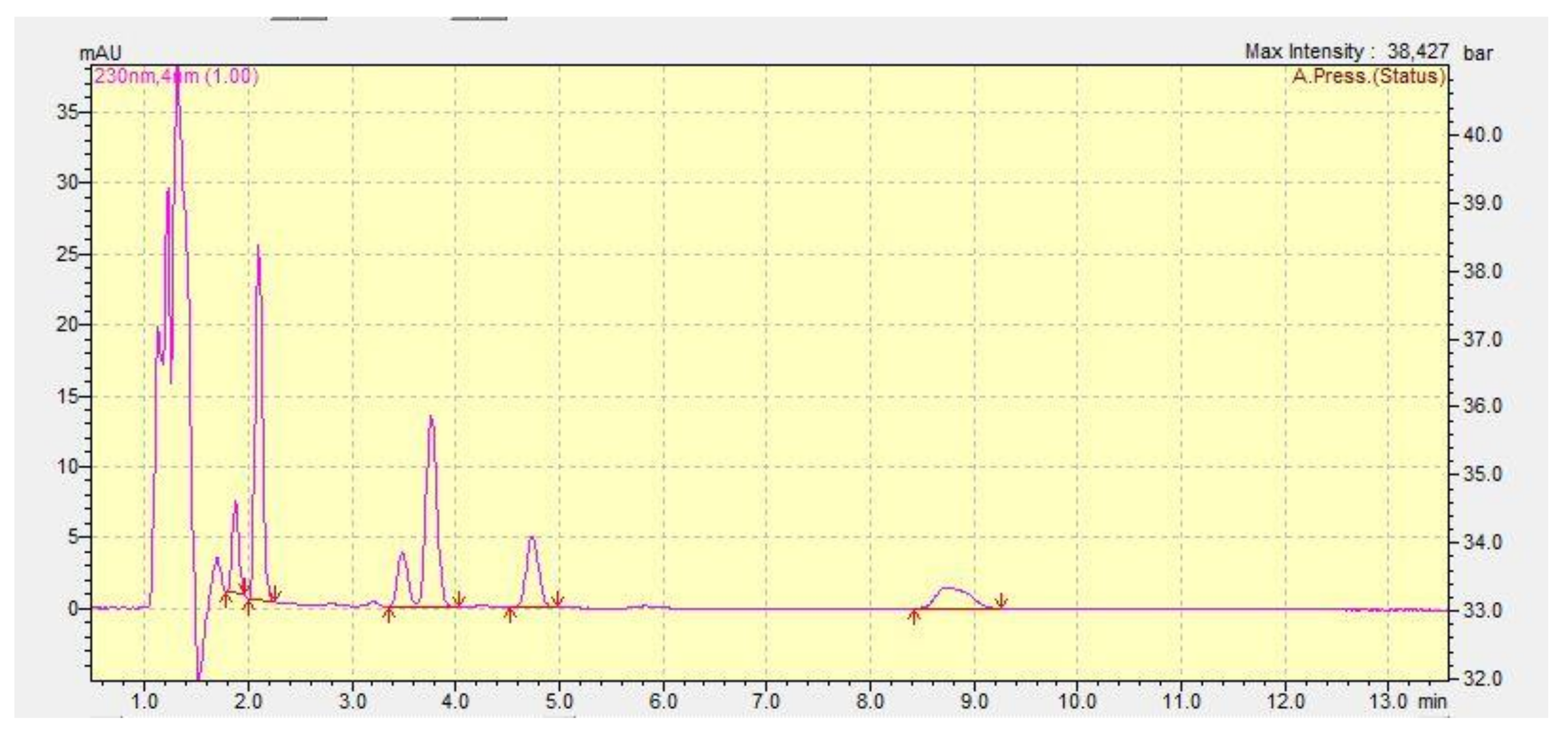
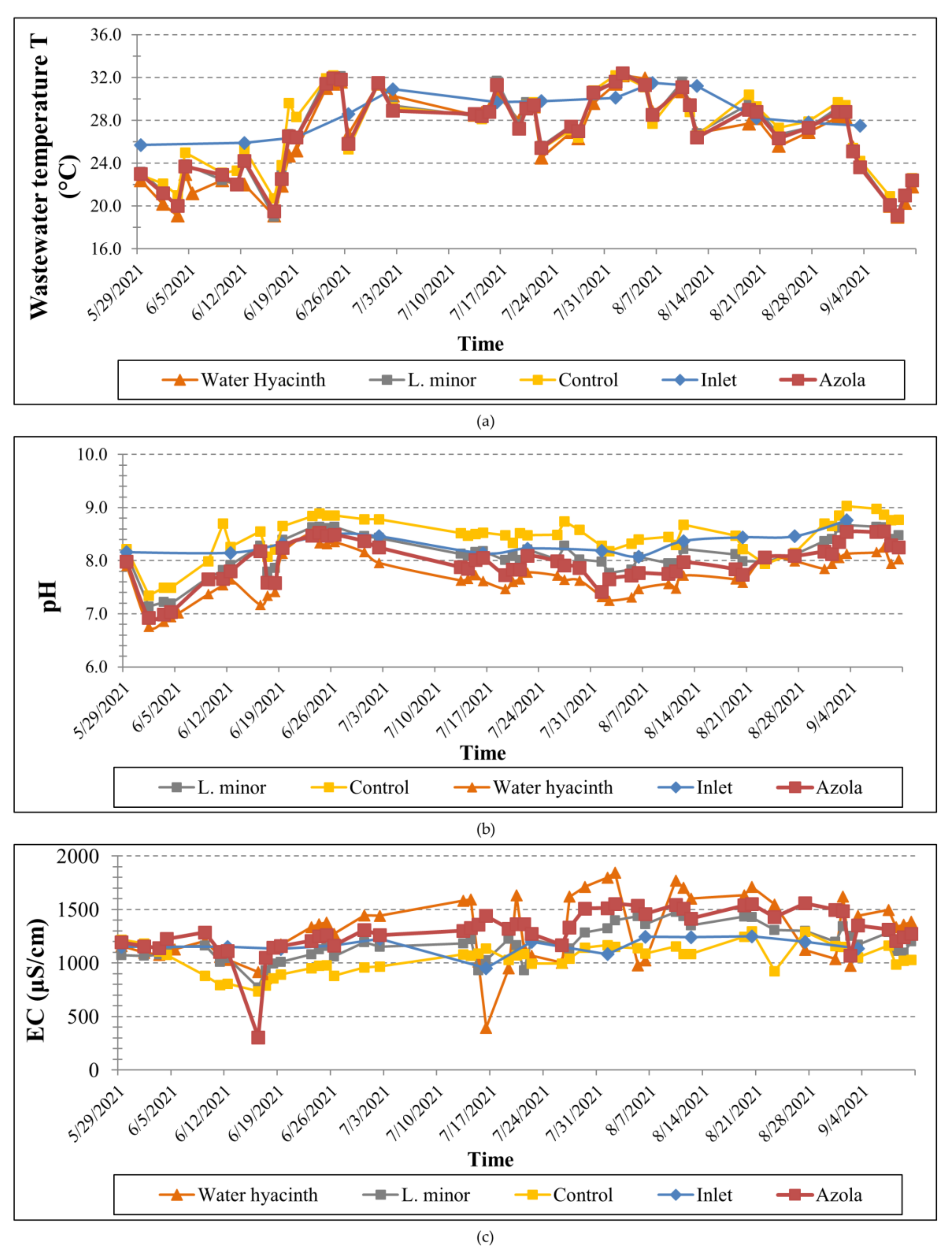
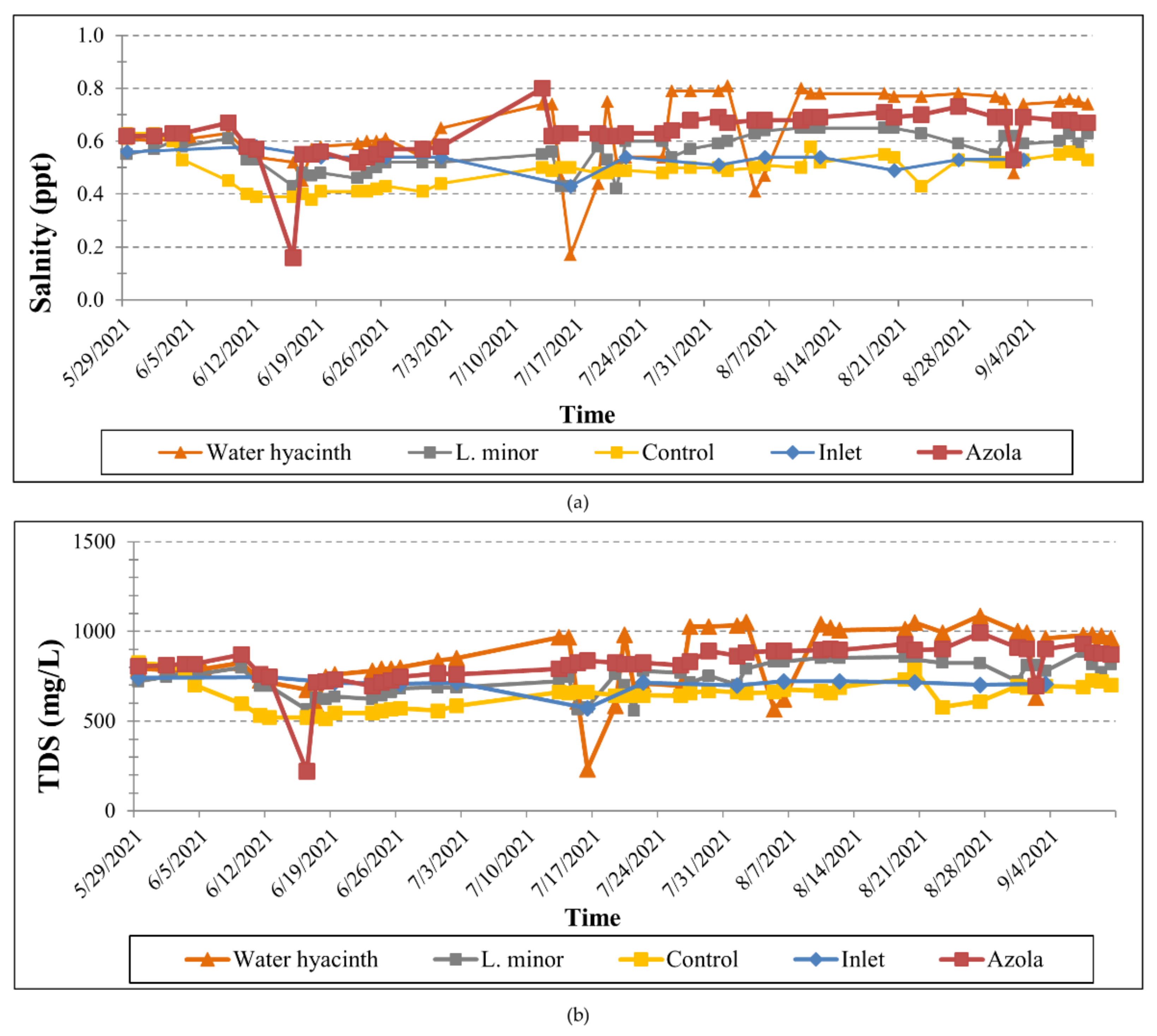
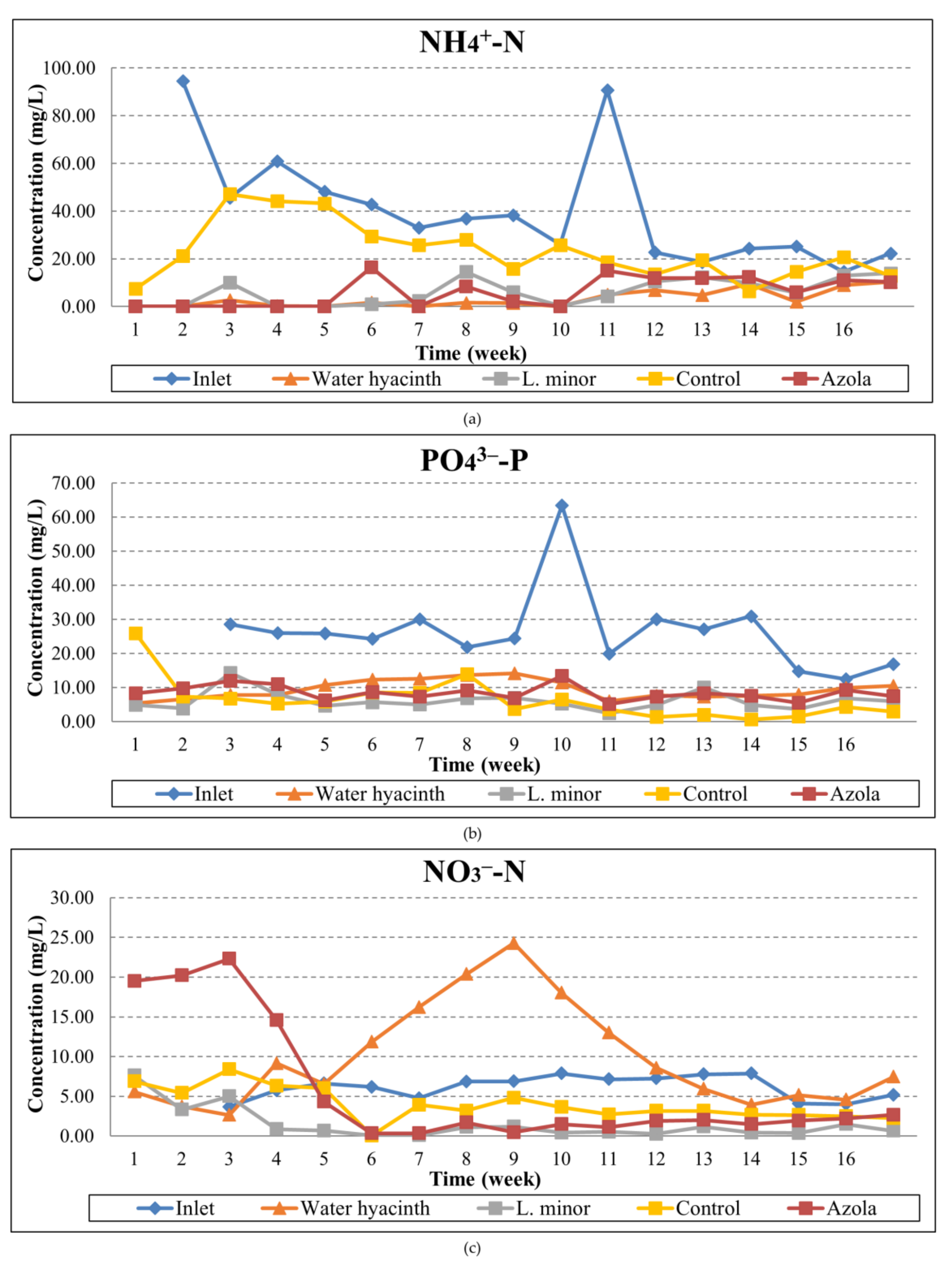
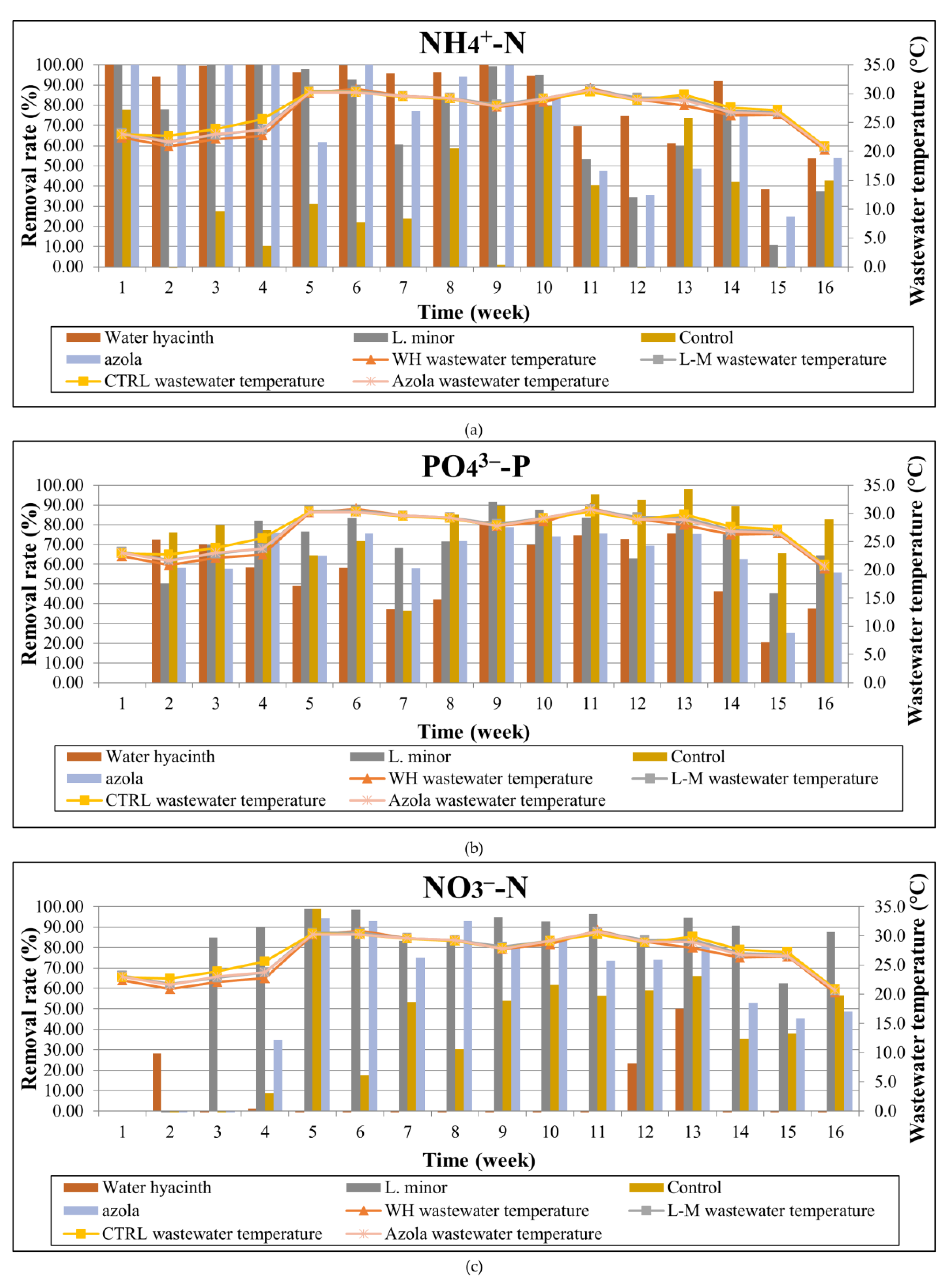
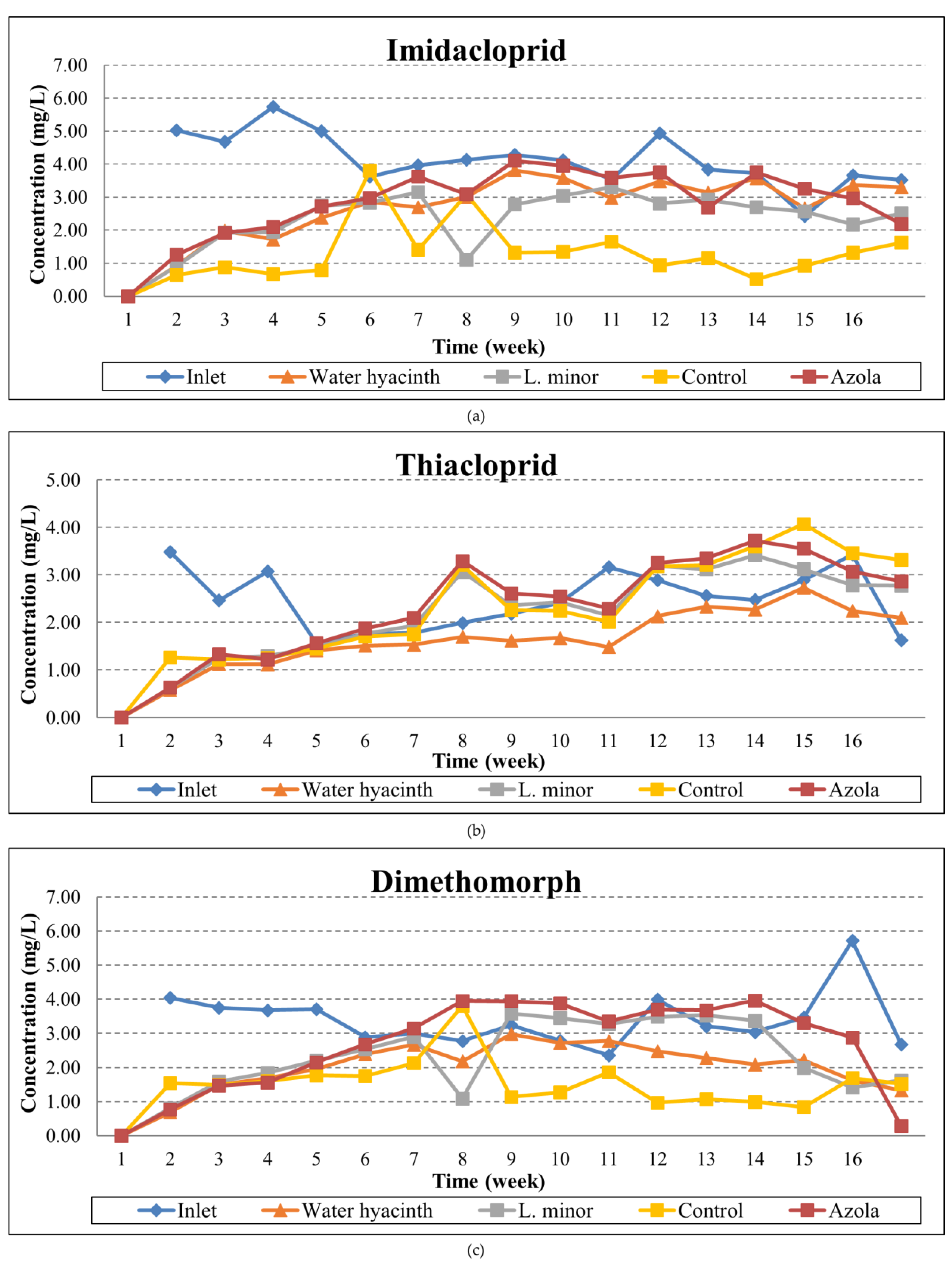

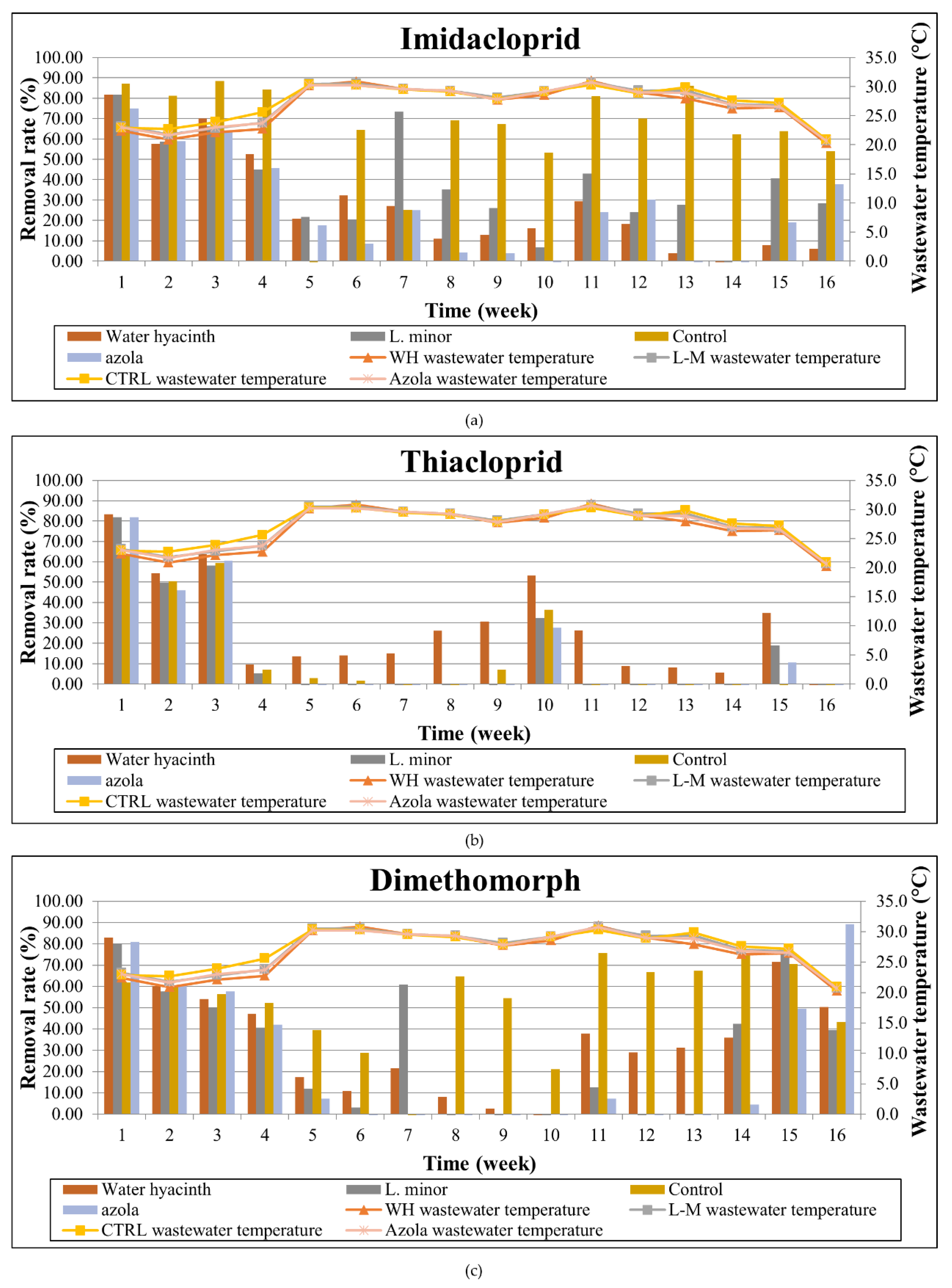

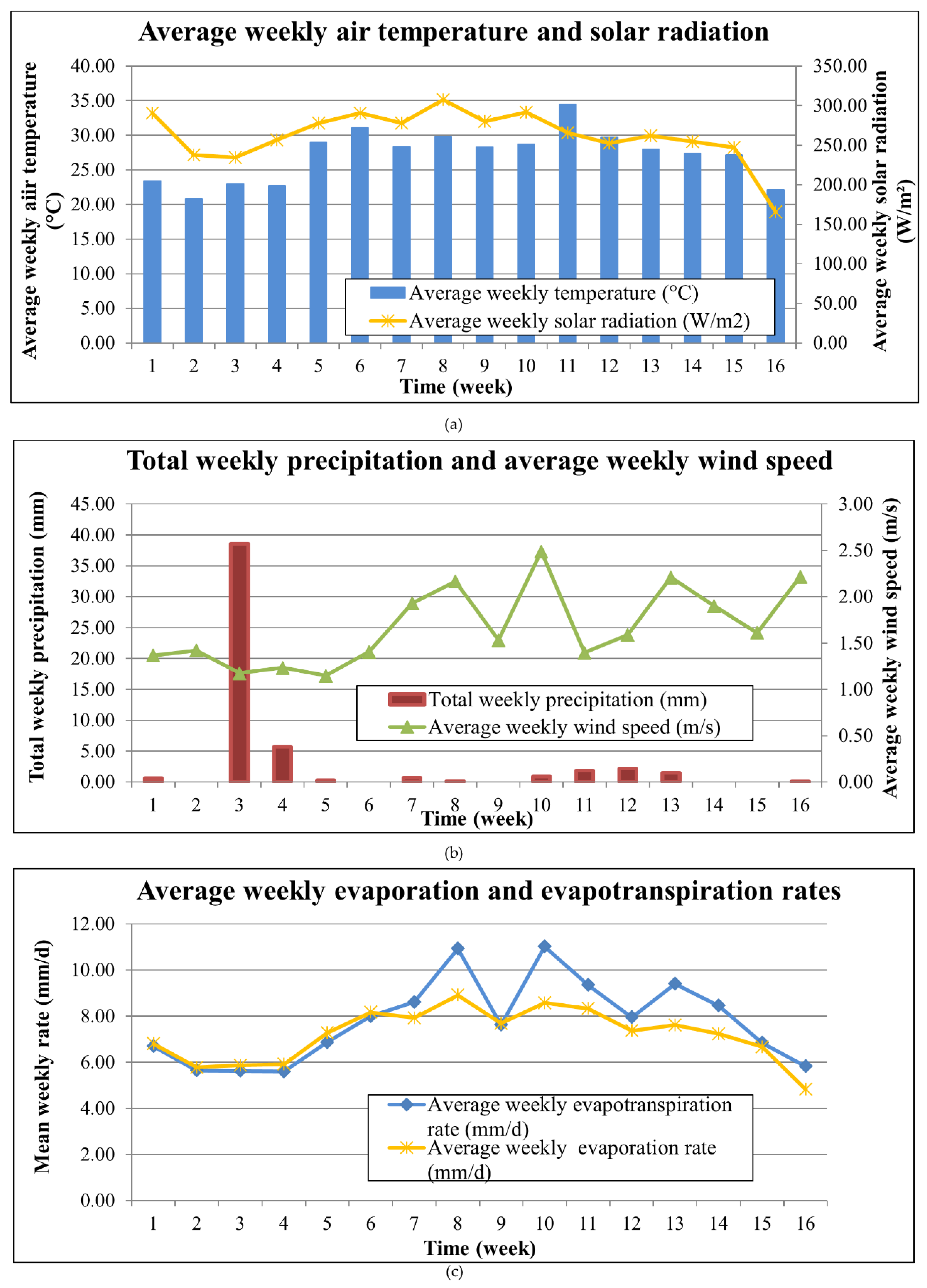
| Substance | NOEC (Studies with L. gibba) | Water Solubility (mg/L) | Koc (Adsorption) (mL/g) | DT50soil | Photolysis | Hydrolysis | DT50water | DT50 System | Type |
|---|---|---|---|---|---|---|---|---|---|
| Myclobutanil | 105 mg as/L | 132 | 225–920 | 191–1216 d lab/ 9–58 d field | Stable | Stable | 4–20 d | 415–838 d | fungicide |
| Imidacloprid | no data | 600 | 109–411 | 27–180 d field | Yes DT50 = 1 h | Stable | >30 d | 129 d | insecticide |
| Difenoconazole | no data | 15 | 400–7730 | 20–242 d field | Stable | Stable | 1–2 d | 307–324 d | fungicide |
| Thiacloprid | 46.8 mg as/L | 184 | 393–870 | 6–16.8 d field | Stable (79.7 d) | Stable | n.a. | 12.1–18 d | insecticide |
| Dimethomorph | no data | 10.7–47.2 | 290–566 | 34–53.4 d lab/ 10–61 d field | Stable (86–107 d) | Stable | 5–15 d | 16–59 d | fungicide |
| Analyte | Detector/ Wavelength | Flow Rate (mL/min) | Injection Volume (μL) | Retention Time (min) | Column Oven Temperature (°C) |
|---|---|---|---|---|---|
| Imidacloprid | UV (230 nm) | 1.0 | 10 | 1.85 | 35 |
| Thiacloprid | UV (230 nm) | 1.0 | 10 | 2.05 | 35 |
| Dimethomorph | UV (230 nm) | 1.0 | 10 | 3.67 | 35 |
| Myclobutanil | UV (230 nm) | 1.0 | 10 | 4.62 | 35 |
| Difenoconazole | UV (230 nm) | 1.0 | 10 | 8.65 | 35 |
| Nitrates | El. Conductivity | 1.0 | 1000 | 13.0 | 30 |
| Phosphates | El. Conductivity | 1.0 | 1000 | 16.8 | 30 |
| Potassium | El. Conductivity | 1.0 | 1000 | 5.6 | 30 |
| Statistical Parameter | T (°C) | Salinity (ppt) | pH | |||||||||
|---|---|---|---|---|---|---|---|---|---|---|---|---|
| Hyac. | Azola | Lemna | Contr. | Hyac. | Azola | Lemna | Contr. | Hyac. | Azola | Lemna | Cont. | |
| Minimum | 19.0 | 19.1 | 19.0 | 19.0 | 0.2 | 0.2 | 0.4 | 0.4 | 6.8 | 6.9 | 7.1 | 7.3 |
| Mean | 26.3 | 26.8 | 26.9 | 27.1 | 0.6 | 0.6 | 0.6 | 0.5 | 7.7 | 8.0 | 8.1 | 8.5 |
| Maximum | 32.2 | 32.4 | 32.5 | 32.2 | 0.8 | 0.8 | 0.7 | 0.6 | 8.5 | 8.6 | 8.7 | 9.0 |
| St. Dev. | 4.01 | 3.81 | 3.91 | 3.66 | 0.14 | 0.09 | 0.07 | 0.06 | 0.40 | 0.39 | 0.37 | 0.38 |
| EC (μS/cm) | TDS (mg/L) | |||||||||||
| Hyac. | Azola | Lemna | Contr. | Hyac. | Azola | Lemna | Contr. | |||||
| Minimum | 394.7 | 306.1 | 771.0 | 737.0 | 233.4 | 221.0 | 559.0 | 513.5 | ||||
| Mean | 1300.3 | 1301.5 | 1181.4 | 1044.9 | 840.0 | 818.3 | 740.3 | 648.0 | ||||
| Maximum | 1845.0 | 1560.0 | 1479.0 | 1297.0 | 1087.5 | 992.0 | 886.5 | 825.5 | ||||
| St. Dev. | 306.30 | 209.43 | 157.19 | 130.48 | 176.85 | 114.28 | 87.81 | 77.57 | ||||
| Pollutant | System | |||
|---|---|---|---|---|
| Azola | Water Hyacinth | Lemna | Control | |
| NH4+-N (%) | ||||
| Mean | 84.3 | 91.9 | 84.7 | 41.8 |
| Max | 100.0 | 100.0 | 100.0 | 79.6 |
| Min | 24.8 | 38.3 | 10.9 | 0.0 |
| PO43−-P (%) | ||||
| Mean | 68.5 | 65.0 | 77.2 | 76.2 |
| Max | 78.8 | 81.9 | 91.6 | 98.1 |
| Min | 25.3 | 20.6 | 45.5 | 36.4 |
| NO3−-N (%) | ||||
| Mean | 6.6 | 20.4 | 76.1 | 35.8 |
| Max | 94.4 | 50.0 | 98.8 | 98.9 |
| Min | 0.0 | 0.0 | 0.0 | 0.0 |
| Imidacloprid (%) | ||||
| Mean | 31.1 | 34.7 | 43.3 | 68.3 |
| Max | 75.0 | 81.7 | 81.9 | 88.3 |
| Min | 0.0 | 0.0 | 0.0 | 0.0 |
| Thiacloprid (%) | ||||
| Mean | 6.6 | 34.5 | 12.6 | 0.9 |
| Max | 81.9 | 83.3 | 81.9 | 63.8 |
| Min | 0.0 | 0.0 | 0.0 | 0.0 |
| Dimethomorph (%) | ||||
| Mean | 22.4 | 41.7 | 32.8 | 53.1 |
| Max | 89.2 | 82.9 | 80.0 | 75.7 |
| Min | 0.0 | 0.0 | 0.0 | 0.0 |
| Myclobutanil (%) | ||||
| Mean | 6.0 | 19.5 | 7.5 | 34.9 |
| Max | 76.7 | 79.7 | 77.1 | 56.3 |
| Min | 0.0 | 0.0 | 0.0 | 0.0 |
| Difenoconazole (%) | ||||
| Mean | 33.2 | 64.8 | 33.8 | 69.0 |
| Max | 92.0 | 94.6 | 82.9 | 95.6 |
| Min | 0.0 | 20.40 | 0.0 | 20.4 |
| Pollutant | F | p-Value | F Crit |
|---|---|---|---|
| NH4+-N * | 12.990 | 1.21 × 10−6 | 2.758 |
| PO43—-P * | 5.555 | 0.002 | 2.769 |
| NO3—-N * | 6.237 | 0.001 | 2.769 |
| Imidacloprid * | 8.370 | 9.82 × 10−5 | 2.758 |
| Thiacloprid | 2.196 | 0.098 | 2.758 |
| Dimethomorph * | 3.322 | 0.026 | 2.758 |
| Myclobutanil * | 4.527 | 0.006 | 2.758 |
| Difenoconazole * | 12.376 | 2.10 × 10−6 | 2.758 |
| Pollutant | ||||||||
|---|---|---|---|---|---|---|---|---|
| Examined Tank | NH4+-N | PO43−-P | NO3−-N | Imidacroprid | Thiacloprid | Dimethomorph | Myclobutanil | Difenoconazole |
| Pearson Correlation Coefficients between Temperature and Pollutant Reduction | ||||||||
| Azola | −0.352 | 0.347 | 0.648 | −0.607 | −0.357 | −0.718 | −0.511 | −0.402 |
| Water hyacinth | −0.082 | 0.096 | −0.364 | −0.480 | −0.197 | −0.591 | −0.450 | −0.497 |
| Lemna | −0.149 | 0.441 | 0.538 | −0.408 | −0.342 | −0.575 | −0.515 | −0.356 |
| Control | 0.098 | 0.129 | 0.594 | −0.251 | −0.202 | −0.044 | −0.308 | 0.276 |
| Pearson correlation coefficients between solar radiation and pollutant reduction | ||||||||
| Azola | 0.340 | 0.441 | 0.329 | −0.289 | 0.250 | −0.622 | 0.081 | −0.049 |
| Water hyacinth | 0.539 | 0.169 | −0.545 | 0.073 | 0.420 | −0.478 | 0.135 | 0.122 |
| Lemna | 0.486 | 0.471 | 0.243 | −0.013 | 0.289 | −0.362 | 0.127 | −0.129 |
| Control | 0.266 | −0.111 | 0.196 | −0.103 | 0.431 | −0.163 | −0.373 | 0.133 |
| Pearson correlation coefficients between evapotranspiration/evaporation and pollutant reduction | ||||||||
| Azola | −0.128 | 0.402 | 0.505 | −0.671 | −0.281 | −0.782 | −0.560 | −0.457 |
| Water hyacinth | 0.022 | 0.091 | −0.368 | −0.514 | −0.038 | −0.690 | −0.456 | −0.210 |
| Lemna | −0.013 | 0.439 | 0.368 | −0.411 | −0.247 | −0.652 | −0.514 | −0.577 |
| Control | 0.317 | 0.053 | 0.413 | −0.179 | 0.041 | −0.170 | −0.445 | 0.350 |
| Pearson correlation coefficients between wind speed and pollutant reduction | ||||||||
| Azola | −0.212 | 0.050 | 0.299 | −0.523 | −0.476 | −0.392 | −0.692 | −0.537 |
| Water hyacinth | −0.297 | −0.184 | −0.114 | −0.624 | −0.299 | −0.422 | −0.559 | −0.131 |
| Lemna | −0.278 | 0.097 | 0.143 | −0.398 | −0.454 | −0.385 | −0.619 | −0.650 |
| Control | 0.473 | 0.142 | 0.284 | −0.078 | −0.496 | −0.206 | −0.331 | 0.532 |
| Pearson correlation coefficients between precipitation and pollutant reduction | ||||||||
| Azola | 0.238 | −0.111 | −0.275 | 0.423 | 0.368 | 0.301 | 0.438 | 0.381 |
| Water hyacinth | 0.174 | 0.203 | 0.096 | 0.466 | 0.308 | 0.225 | 0.369 | 0.333 |
| Lemna | 0.236 | −0.047 | 0.071 | 0.335 | 0.334 | 0.191 | 0.398 | 0.305 |
| Control | −0.020 | 0.039 | −0.213 | 0.293 | 0.336 | 0.067 | 0.271 | −0.272 |
Publisher’s Note: MDPI stays neutral with regard to jurisdictional claims in published maps and institutional affiliations. |
© 2022 by the authors. Licensee MDPI, Basel, Switzerland. This article is an open access article distributed under the terms and conditions of the Creative Commons Attribution (CC BY) license (https://creativecommons.org/licenses/by/4.0/).
Share and Cite
Pavlidis, G.; Zotou, I.; Karasali, H.; Marousopoulou, A.; Bariamis, G.; Nalbantis, I.; Tsihrintzis, V.A. Experiments on Pilot-Scale Constructed Floating Wetlands Efficiency in Removing Agrochemicals. Toxics 2022, 10, 790. https://doi.org/10.3390/toxics10120790
Pavlidis G, Zotou I, Karasali H, Marousopoulou A, Bariamis G, Nalbantis I, Tsihrintzis VA. Experiments on Pilot-Scale Constructed Floating Wetlands Efficiency in Removing Agrochemicals. Toxics. 2022; 10(12):790. https://doi.org/10.3390/toxics10120790
Chicago/Turabian StylePavlidis, George, Ioanna Zotou, Helen Karasali, Anna Marousopoulou, Georgios Bariamis, Ioannis Nalbantis, and Vassilios A. Tsihrintzis. 2022. "Experiments on Pilot-Scale Constructed Floating Wetlands Efficiency in Removing Agrochemicals" Toxics 10, no. 12: 790. https://doi.org/10.3390/toxics10120790





